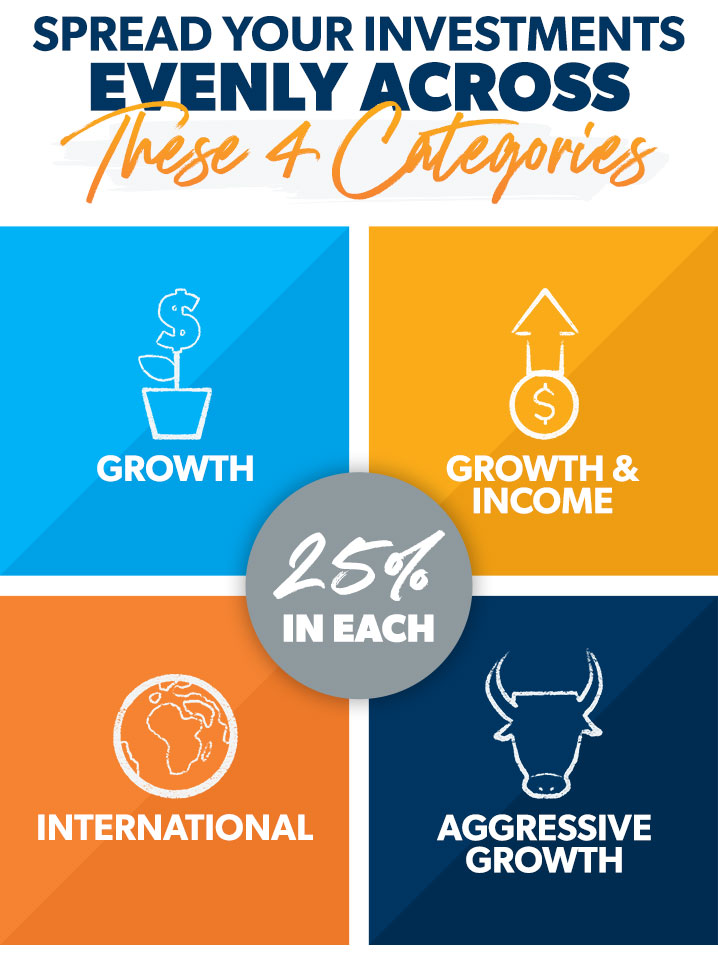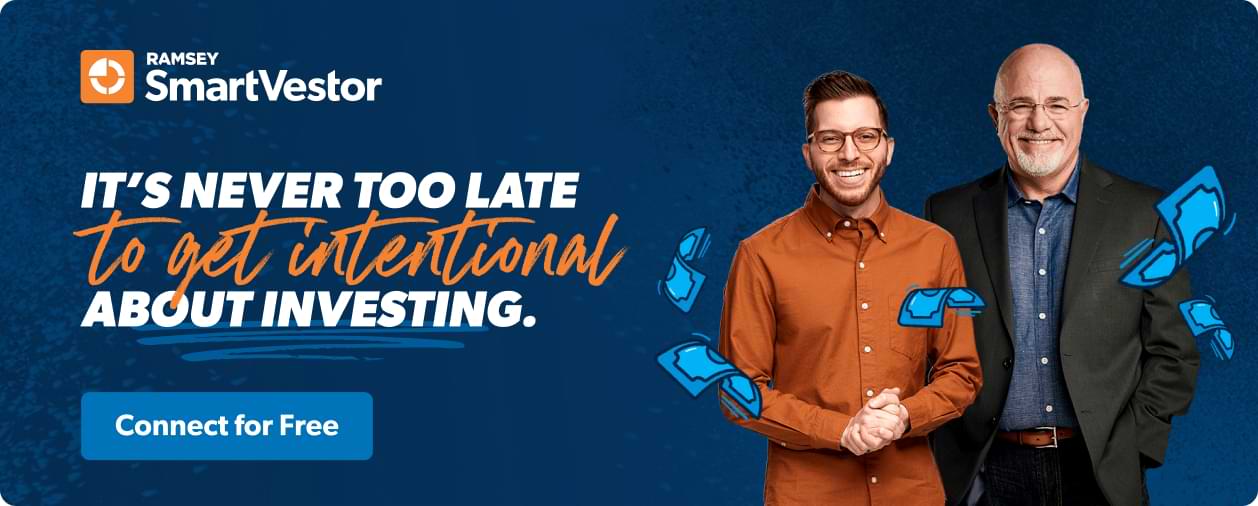
Listen to this article
It’s that nagging thought that pops into your mind whenever you think about the future: I need to save for retirement. It’s easy to ignore or put off for another day . . . or another year. Maybe you haven’t started yet because retirement seems like such a long way off. Or maybe you’ve dragged your feet because you just don’t know where to start.
Well, today’s the day to start changing your future!
One of the best ways to save for retirement is with a Roth IRA. In fact, you should take advantage of all the Roth options you have—whether that’s an IRA or a Roth 401(k). The biggest reason? Taxes. The money you put into your Roth IRA grows tax-free. And you won’t owe taxes when you use the money from your Roth IRA once you retire. But as awesome as a Roth IRA is, it has a specific place in your wealth-building plan. We’ll get to that a little later.
For now, let’s start by taking the mystery out of how to open a Roth IRA and why you should. Don’t worry—it’s really easy!
Why Start a Roth IRA?
A Roth IRA is a great way to supplement your 401(k) or other workplace retirement plan. Fun fact: 8 out of 10 millionaires invested in their company’s 401(k) according to our National Study of Millionaires. That means their boring old workplace retirement account played a huge part in their financial success! On top of that, 3 out of 4 millionaires invested outside of their company plans too. But if you don’t have a retirement plan at work—and lots of people don’t—a Roth IRA isn’t just a nice thing to have. It’s essential.
With a Roth IRA, you won’t pay any taxes on the money you take out in retirement once you hit age 59 1/2. That’s because you invest in a Roth IRA with after-tax money—meaning you’ve already paid taxes on it. So it’s free to grow over the years in your account, but you won’t have a tax bill that’s growing too!
How to Open a Roth IRA
Opening a Roth IRA doesn’t take a bunch of time or paperwork. It’s just as simple as opening a checking account or contacting a financial advisor. Many banks offer Roth IRAs through an online application. You could also open a brokerage account with an investment firm (online or in person). A brokerage account is an investment account you can open directly through a bank or brokerage firm that lets you buy and sell all kinds of different investments.
Does the thought of pulling out your retirement at 59 1/2 without having to worry about paying taxes sound appealing? If so, we’ll help you get started! Let’s walk through seven steps to open a Roth IRA.
1. Find out if you’re eligible and ready.
First things first. Before you can open a Roth IRA, you have to make sure you meet the income limits to contribute to a Roth IRA.
In 2022, as long as your adjusted gross income is less than $129,000 for single filers and $204,000 for married couples filing jointly, you can contribute the maximum amount to a Roth IRA.1
Market chaos, inflation, your future—work with a pro to navigate this stuff.
Remember when we said your Roth IRA has a specific place in your wealth-building plan? Here’s the deal: Eligibility for an IRA isn’t all you should keep in mind. You also need to make sure saving for retirement fits into your budget. That means you’ll need to be halfway through the Baby Steps. Baby Step 1 is saving a $1,000 starter emergency fund. Baby Step 2 is getting out of debt (everything except your house) using the debt snowball method. Baby Step 3 is saving three to six months of expenses for a fully funded emergency fund.
And then you get to Baby Step 4—investing 15% of your household income for retirement. When you’re trying to figure out where to invest for retirement first, remember: Match beats Roth beats Traditional. This means you should invest in your 401(k) up to your match (hey, it’s free money!), then max out your Roth IRA. If you haven’t reached 15% at that point, go back and invest in your 401(k). And if you have a Roth 401(k) at work, great! You can invest your entire 15% there.
Working through the Baby Steps—and getting out of debt—is the quickest right way to build wealth. So if you haven’t paid off all your debt or saved up an emergency fund, stop investing for now. No exceptions!
There’s actually a special group of people called Baby Steps Millionaires who followed these exact steps to build a net worth of a million dollars or more. Want to learn even more about how they built their wealth? Dave Ramsey’s new book, Baby Steps Millionaires, will show you the proven path that millions of Americans have taken to get out of debt and build wealth—and how you can too!
2. Choose where you want to invest.
While you have quite a few options for how to set up your Roth IRA, the route you choose depends on how comfortable you are doing things on your own. If DIY is in your DNA, then go online and set up a Roth IRA.
But odds are, you probably have questions an online chatbot can’t answer. If you feel more comfortable working with someone face-to-face, reach out to a SmartVestor Pro. They’re RamseyTrusted investing professionals who can guide you through all your retirement options, including setting up a Roth IRA or rolling over your 401(k) funds to an IRA.
3. Fill out the forms.
Whether you work with a pro or sign up on your own, you’ll have some paperwork (or online forms) to fill out to open your Roth account. Make sure you’ve got all the information below handy once you’re ready to fill out the forms:
- Your driver’s license or other government-issued form of photo identification
- Your Social Security number
- Your bank’s routing number and your checking or savings account number
- Your employer’s name and address (optional)
You’ll also choose a beneficiary (or beneficiaries) who will inherit your Roth IRA if you die. You’ll need their name, Social Security number and date of birth too.
4. Choose investments within your Roth IRA.
So, once you’ve opened your account, your next step is to choose what to invest in. Remember: Your Roth IRA is not an investment in itself—it only holds your investments and protects them from income taxes. You can put all kinds of different investments into your Roth IRA. Choosing your investments is by far the most difficult step in starting a Roth IRA because you’ve got so many options.
We recommend a mix of mutual funds because they allow you to spread your investments across a lot of companies, which lowers your risk while allowing your money to grow. That’s called diversification. If you put all your eggs in one basket (single stocks or trendy investments like cryptocurrency), at some point, you’re going to end up with a mess on your hands.
Here are some other benefits of mutual funds:
- Mutual funds allow you to use the power of the stock market’s long history of growth without taking on the risk of single stock investing. The stock market historically has an annual average rate of return between 10–12%.2
- Mutual funds are managed by teams of investing professionals who make sure the mutual fund performs at the highest level possible. They live and breathe this stuff!
- If you decide to work with an investing professional to open your Roth IRA and choose your mutual funds, the up-front commissions pay for your pro’s time and expert advice—not just at the time you open your account but for as long as you invest in your Roth IRA.
5. Choose investments for the long term.
Investing for retirement is a marathon, not a sprint. We recommend a buy-and-hold strategy. A buy-and-hold strategy is exactly what it sounds like—you’re buying shares of mutual funds and then holding them for a long time. That means you don’t go chasing quick returns.
Some years, you’ll see giant returns on your investments, and in other years, you might see negative returns. The stock market is like a roller coaster with ups and downs. The only people who get hurt are the ones who try to jump off the ride before it’s over.
The folks who became Baby Steps Millionaires didn’t freak out over what happened to their investments in any particular year. They didn’t pull their money out when the market started tanking. They stayed focused and kept investing month after month, year after year—no matter what was happening in the stock market.
6. Choose mutual funds with strong returns.
When you’re choosing your mutual funds, look for funds with a long track record—10 years or more—of strong returns that consistently outperform the S&P 500. They’re out there! You’ll also want to spread your investments evenly across these four types of funds:
- Growth and Income: These funds create a stable foundation for your portfolio by investing in big American companies that have been around for decades. They also pay dividends. (Dividends are payments companies make to their stockholders to share their profits.) You might find these funds listed under large-cap or blue chip funds.
- Growth: These funds are made up of medium or large U.S. companies that are up and coming. Sometimes called mid-cap or equity funds, they’re more likely to ebb and flow with the economy.
- Aggressive Growth: Meet the wild child of your portfolio. When these funds are up, they’re really up, and when they’re down, they’re really down. Aggressive growth funds normally invest in smaller companies that have tons of potential.
- International: Investing in international funds gives you a chance to invest in big non-U.S. companies you already know and love—like Nestlé, which is based in Switzerland. International funds spread your risk beyond U.S. soil. Just don’t confuse them with global funds, which bundle U.S. and foreign stocks together.

7. Set up contributions to your Roth IRA.
Ever heard the phrase, “Out of sight, out of mind”? You can actually use this principle in your favor! How? By automating your investing. You can set up payroll deductions, automatic bank withdrawals or direct deposits to fund your Roth IRA.
But hold up. There are limits to how much money you can put into IRAs each year. For 2022, you can invest $6,000 in either a traditional IRA or a Roth IRA. If you’re 50 or older and need to catch up, you can add an extra $1,000 for a total of $7,000.3
Setting up automatic IRA contributions will take extra paperwork, but it’s worth the time to make sure you’re putting away money for retirement consistently. And because you never see that money, you won’t even miss it! Plus, you won’t be tempted to use it to pay for new tires or a new pair of jeans.
But don’t go so far with this idea that you never check in on your investments. You’ve got to make sure your investing plan is still on track so you can make changes if you need to.
Start Investing Today
Starting a Roth IRA is easier than you thought, right? Now, go get started!
But if you’re still a little unsure about this whole process, our SmartVestor program can connect you with a RamseyTrusted investing pro who can help you make sense of your investing options.
This article provides general guidelines about investing topics. Your situation may be unique. If you have questions, connect with a SmartVestor Pro. Ramsey Solutions is a paid, non-client promoter of participating Pros.


